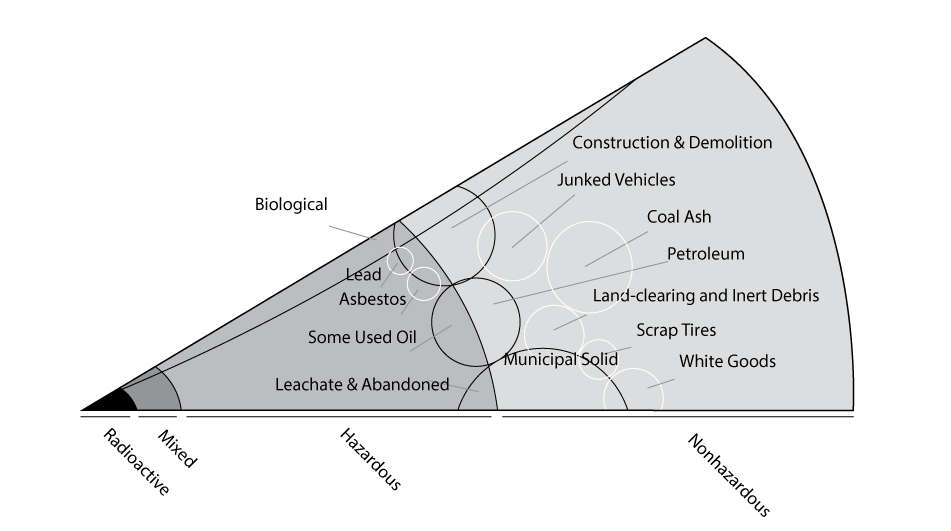
I place waste at the center of environmental law based on my personal, broad definition of waste. My definition includes anything humans produce that isn’t needed for the purpose of the production and that isn’t used beneficially right away–things that we could do without, such as the heat from an incandescent bulb, in most circumstances. Yes, there are times we might want a light bulb that also produces a lot of heat, but in most settings we could duplicate the desired light quality and quantity with a bulb that saves energy, by not producing excess heat. Similarly, the light from a bulb that is turned on, but not serving any useful purpose, is also waste.
For a working environmental lawyer, though, this is a bit esoteric. What that lawyer, or anyone trying to understand the positive law of the environment, needs is a way to keep all the parts of the legal definition of “solid waste” in place. In other words, our law in NC (and elsewhere in the US) has created many sub-categories of waste, and the regulation of these sub-categories varies widely. Which means the costs vary widely. So I use a waste map that I’ve created to help keep track of regulatory categories of waste.
So this map covers only things that fit within our State definition of solid waste–but that is a lot of things, and that may be the first and best use of the map: to show how many legal categories of waste there are (and these are by no means the only important ones–these are just the main categories one runs into under North Carolina’s definition of solid waste.
This map tries to convey the way the law regulates various waste streams. As you go left in the diagram, the regulations increase, and so does the cost of proper disposal. Each of these categories has its own definition. Waste generators strive mightily to keep the wastestreams for which they are legally responsible as far to the right on the map as possible. Over the course of this blog I hope to touch on some of the challenges and successes that each of these categories has yielded in NC.

6 Responses to “The waste map”
John Stephens
Richard – for your map as a kind of triangle (or pie piece – are you making a subconscious reference to Trivial Pursuit?), do you also mean to convey the relative quantity of waste by category? It seems reasonable to me that radioactive is a very small proportion compared to “regular, old household and business trash.”
I’ll be interested to see if there are legal distinctions which match your use of black circles (or semi-circles) and white circles to designate categories within the pie piece. Be sure to dispose of the pie plate properly [wink].
Richard Whisnant
John,
you’re perceptive in thinking I meant to convey the relative quantity of waste by category, but I decided not to claim that I was doing that, for two reasons: (1) I don’t have all the data to actually back up the size of each category, and (2) I’m almost certain that the size of the differences depicted do not in any way approximate the actual scale of different volumes for these wastestreams. In fact, I’m guessing it would be almost impossible to get the relative scales right and still present the diagram on a normal sized screen, with all the categories visible. So the shape sizes came out as a subjective and very, very loose representation of different quantities. I’m glad you picked up on it, though. As for the pie plate allusion and the circle colors, I owe those entirely to the graphic genius of Robby Poore. I originally drew this as a triangle with a lot of different colored circles, sort of a Big Rock Candy Mountain of waste, if you will. But it didn’t translate at all into black and white. I went to Robby and he quickly transformed it into the nice graphic you see in the post. Thanks for the comment.
John Stephens
Richard – for your map as a kind of triangle (or pie piece – are you making a subconscious reference to Trivial Pursuit?), do you also mean to convey the relative quantity of waste by category? It seems reasonable to me that radioactive is a very small proportion compared to “regular, old household and business trash.”
I’ll be interested to see if there are legal distinctions which match your use of black circles (or semi-circles) and white circles to designate categories within the pie piece. Be sure to dispose of the pie plate properly [wink].
Richard Whisnant
John,
you’re perceptive in thinking I meant to convey the relative quantity of waste by category, but I decided not to claim that I was doing that, for two reasons: (1) I don’t have all the data to actually back up the size of each category, and (2) I’m almost certain that the size of the differences depicted do not in any way approximate the actual scale of different volumes for these wastestreams. In fact, I’m guessing it would be almost impossible to get the relative scales right and still present the diagram on a normal sized screen, with all the categories visible. So the shape sizes came out as a subjective and very, very loose representation of different quantities. I’m glad you picked up on it, though. As for the pie plate allusion and the circle colors, I owe those entirely to the graphic genius of Robby Poore. I originally drew this as a triangle with a lot of different colored circles, sort of a Big Rock Candy Mountain of waste, if you will. But it didn’t translate at all into black and white. I went to Robby and he quickly transformed it into the nice graphic you see in the post. Thanks for the comment.
Environmental Law in Context | Municipal solid waste
[…] of the most important categories of solid waste, as shown on my waste map, is “municipal solid waste” (often abbreviated as “MSW”). This is the waste that comes from […]
Environmental Law in Context | Municipal solid waste
[…] of the most important categories of solid waste, as shown on my waste map, is “municipal solid waste” (often abbreviated as “MSW”). This is the waste that comes from […]